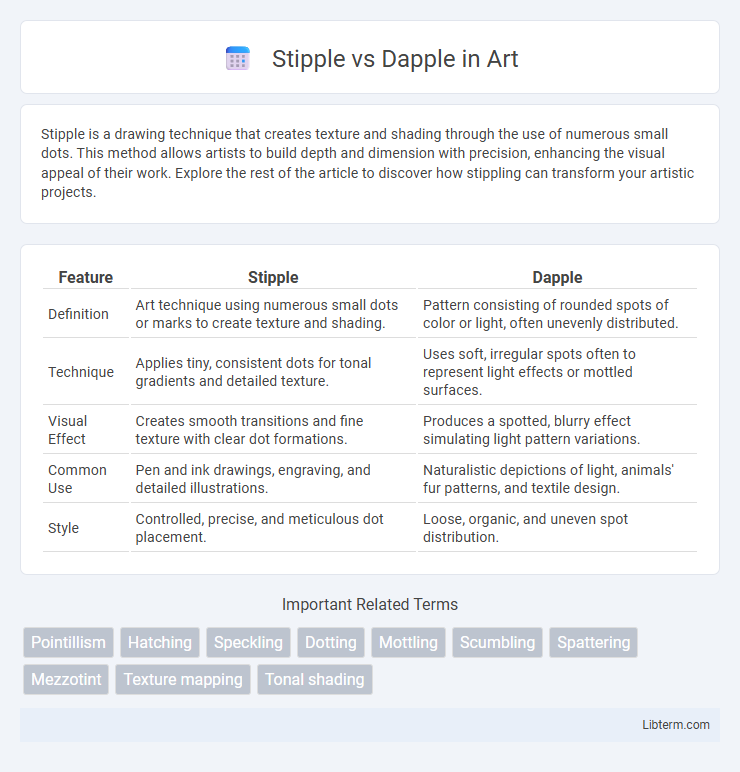Stipple is a drawing technique that creates texture and shading through the use of numerous small dots. This method allows artists to build depth and dimension with precision, enhancing the visual appeal of their work. Explore the rest of the article to discover how stippling can transform your artistic projects.
Table of Comparison
| Feature | Stipple | Dapple |
|---|---|---|
| Definition | Art technique using numerous small dots or marks to create texture and shading. | Pattern consisting of rounded spots of color or light, often unevenly distributed. |
| Technique | Applies tiny, consistent dots for tonal gradients and detailed texture. | Uses soft, irregular spots often to represent light effects or mottled surfaces. |
| Visual Effect | Creates smooth transitions and fine texture with clear dot formations. | Produces a spotted, blurry effect simulating light pattern variations. |
| Common Use | Pen and ink drawings, engraving, and detailed illustrations. | Naturalistic depictions of light, animals' fur patterns, and textile design. |
| Style | Controlled, precise, and meticulous dot placement. | Loose, organic, and uneven spot distribution. |
Introduction to Stipple and Dapple
Stipple and Dapple refer to distinct texturing techniques used in art and design, each creating unique visual effects. Stippling involves the use of numerous small dots to build up shading and texture, offering detailed and controlled tonal variation. Dapple, on the other hand, features irregular spots or patches, often with softer edges, producing a natural, mottled appearance commonly seen in patterns inspired by animal fur or light filtering through leaves.
Defining Stipple: Techniques and Uses
Stipple is a drawing technique that uses numerous small dots to create shading, texture, and depth, often employed in pen-and-ink illustrations and engraving. This method allows artists to achieve subtle gradients and detailed tonal variations by varying dot density and size, making it ideal for realistic and intricate imagery. Stippling finds applications in scientific illustration, tattoo art, and printmaking due to its precise control over texture and contrast.
Understanding Dapple: Characteristics and Methods
Dapple refers to a pattern of irregular, fading spots or patches of lighter color on a darker base, often seen in horse coats and foliage. Characterized by soft-edged areas with varied shapes and sizes, dapple patterns create a natural, mottled appearance distinct from the more uniform and consistent stipple pattern. Methods to identify dapple include observing the gradual transitions in hue and the scattered distribution of light spots that lack the pixelated precision typical of stippling techniques.
Historical Origins of Stipple and Dapple
Stipple and dapple techniques both trace back to early artistic and textile traditions, with stipple originating in the Renaissance era as a method for creating shading and texture through countless small dots on engravings and prints. Dapple has roots in naturalistic art and weaving, mimicking the mottled patterns found on animal coats and foliage, frequently used in medieval tapestries to represent light and shadow effects. Both methods evolved to enhance visual depth in artwork, with stipple emphasizing detailed gradation and dapple capturing organic irregularities.
Visual Differences: Stipple vs. Dapple
Stipple patterns consist of numerous small, closely spaced dots creating texture and shading, imparting a granular, detailed look. Dapple patterns feature irregular, larger spots or patches with varying shades, often resembling natural light spots or mottled fur, giving a more organic, scattered appearance. Visually, stippling provides fine, intricate detail, while dappling offers a bold, uneven distribution of color or light.
Applications in Art and Design
Stipple and dapple techniques offer distinct textural effects in art and design, with stipple involving fine dots to create shading and depth, ideal for detailed illustrations or engraving. Dapple produces irregular, patchy patterns reminiscent of light filtering through foliage, commonly used in painting and textile design to evoke natural, organic aesthetics. Both methods enhance visual interest and dimensionality but cater to different stylistic and compositional needs.
Pros and Cons of Stipple Technique
The stipple technique offers precise control over texture and shading by using numerous small dots, which allows for intricate detailing and a soft gradient effect ideal for fine art and illustrations. Its primary advantage lies in its ability to create subtle tonal variations and depth without harsh lines, making it suitable for realistic depictions and delicate subjects. However, the stipple method can be time-consuming and labor-intensive, requiring significant patience and skill, and may lack the dynamic expressiveness found in other techniques like dapple, which uses broader, more varied marks for a vibrant, textured appearance.
Advantages and Limitations of Dapple Approach
The Dapple approach excels in capturing complex textures and subtle tonal variations, making it ideal for detailed image processing and enhancement tasks. Its advantage lies in preserving fine details and producing natural-looking effects, but it requires higher computational resources compared to simpler methods like Stipple. Limitations include slower processing speeds and potential over-smoothing in areas with abrupt texture changes, which may affect overall image sharpness.
Choosing the Right Technique for Your Project
Choosing between stipple and dapple techniques depends on your project's texture and detail requirements, as stippling uses numerous small dots to create shading and depth while dappling employs soft, uneven patches for a mottled effect. Stippling works best for precise, intricate designs like botanical illustrations or technical drawings, offering high control over light and shadow gradients. Dappling suits projects needing a more organic, natural look such as landscape paintings or fabric patterns, where subtle color transitions enhance visual interest.
Conclusion: Stipple or Dapple?
Stipple and Dapple represent distinct texture techniques, where Stipple employs numerous small dots to create shading and depth, and Dapple uses irregular, spot-like patterns reminiscent of light spots on surfaces. Choosing between Stipple and Dapple depends on the desired visual effect: Stipple offers precise, detailed gradation ideal for intricate illustrations, while Dapple provides a more organic, natural appearance suited for depicting light and texture variations. For highly controlled tonal work, Stipple is preferable; for expressive, nature-inspired patterns, Dapple is the optimal choice.
Stipple Infographic

 libterm.com
libterm.com